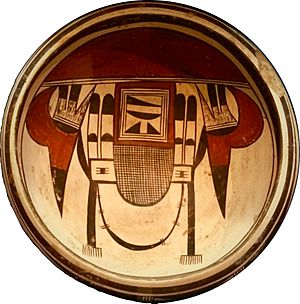Fannie Nampeyo facts for kids

Fannie Nampeyo (1900–1987) was a very talented potter. She continued the amazing traditions of her famous mother, Nampeyo of Hano. Her mother was a legendary artist in Hopi pottery. Fannie was also known as Fannie Lesou Polacca and Fannie Nampeyo Polacca.
Contents
Fannie's Life Story
Growing Up
Fannie Nampeyo Polacca was the youngest of three daughters. Her mother was Nampeyo of Hano. Fannie was born in the Hopi-Tewa Corn Clan home. This home was on First Mesa in the Hopi Reservation in Arizona.
Fannie was first named Popongua. This means "Picking Piñons". Later, she was given the name "Fannie" by missionaries or health workers. She only went to school until third grade.
Starting a Family and Pottery
In the early 1920s, Fannie married her cousin, Vinton Polacca. This was a bit unusual for their tradition. Soon after, making pottery became very important to Fannie.
The couple moved to Sand Hills. There, Vinton worked on a cattle ranch. Fannie started taking pottery seriously at this time. From 1934 to 1937, they lived as ranchers. Then, they left ranching. Vinton began working in government schools.
The family moved to Keams Canyon. All their children finished high school there. While in Keams Canyon, Fannie also had a successful tamale business.
Working with Her Mother
During this time, Fannie Nampeyo worked more and more with her mother, Nampeyo. Her mother's eyesight was getting worse. Fannie helped her mother paint and decorate pottery. She also helped her father polish the pots.
At first, Fannie signed pieces made with her mother simply "Nampeyo." This was because her mother could not read or write. Later, they began signing their shared pieces as "Nampeyo Fannie." Pieces made only by Fannie were signed "Fannie Nampeyo." She sometimes added a corn symbol to her work.
Fannie's Pottery Art
Her Unique Style
Fannie was a very active potter from 1920 to 1987. She became known as an amazing potter during her lifetime. She used black and red colors on yellow pots. She also used black on yellow. She made jars, cups, and saucers.
Fannie also created tiny miniature pots. She made special bowls shaped like birds. Her favorite designs included clouds, rain, feathers, and stars. She also used patterns about migrations. Besides pottery, she also made quilts.
Awards and Recognition
Fannie's pottery won a first-place blue ribbon. This was at the "Hopi Show" in July 1961. The show was held at the Museum of Northern Arizona. Her artwork is now part of important collections. These include the University of Oklahoma's Fred Jones Jr. Museum of Art. Her work is also at The Cleveland Museum of Art.
Later Years and Legacy
Family and Community Role
Fannie became the leader, or matriarch, of the Hopi-Tewa Corn Clan. Her mother, Nampeyo, had held this role before her. "Nampeyo" is actually a special title. It is used by the matriarch of the Hopi-Tewa Corn Clan.
Fannie and her husband Vinton were among the first families. They joined the Church of Jesus Christ of Latter-day Saints at First Mesa. Fannie had 13 children. Sadly, five of them died shortly after birth.
Passing on the Tradition
Her other seven children became excellent potters. They learned their skills from their mother. Several of them became famous in their own right. These include Thomas Polacca, Elva Nampeyo, Tonita, Iris Youvella, Leah, Harold, and Elsworth. Fannie Nampeyo Polacca passed away in 1987.
See also
- Sikyátki
- Hopi-Tewa
- Puebloans
- First Mesa
- Art of the American Southwest
- Tewa
- Nampeyo, potter, mother of Fannie Nampeyo Polacca
- Elva Nampeyo, potter, daughter of Fannie Nampeyo Polacca

